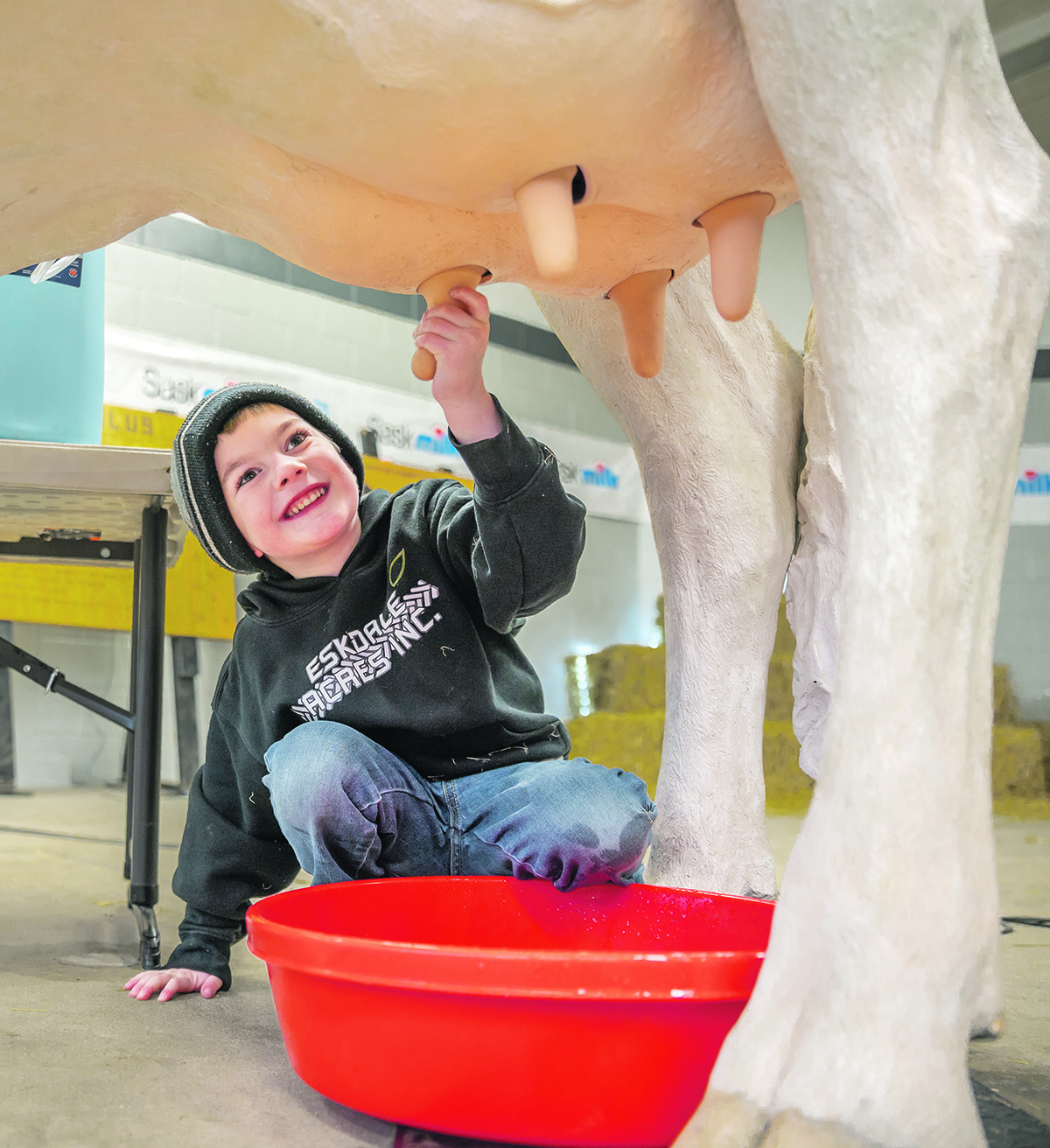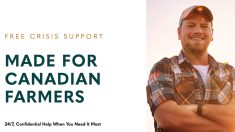MIT researchers visit Agribition as part of their study into how data can best be communicated with the public
When “research” and “agriculture” are in the same sentence, it’s typically about new crop science or livestock innovations. However, a group of researchers at Massachusetts Institute of Technology is changing it up.
“Essentially, what we’re interested in, here at Agribition, is looking at data communication in agriculture – very broadly speaking,” said Amy Fox, a postdoctoral research fellow at MIT who originally grew up on a cattle farm in Alberta.
“And we’re particularly focused on sort of mapping the information ecosystem between companies … grain growers and livestock operators, as well as advocacy agencies … and media outlets.”
Read Also

VIDEO: Bittersweet harvest for this family farmhand
Bruce Burnett helps his brother harvest wheat and canola for the last time on the family farm in Manitoba where they both grew up.
The research is in its early, exploratory stage so there isn’t a clear hypothesis or target in mind to prove. Right now, the researchers’ interest is in mapping the flow of information between the various groups.
They are paying particular attention to issues that may be stirring mistrust or myths among the public and the agricultural community, such as hormone and antibiotic free and non-genetically modified food.
However, there are some large-scale ambitions at play to guide research — develop a theory.
“The idea would be to develop the theory, like the sort of communication theory that could inform design practice to help communicate with sceptical or disaffected publics,” Fox said.
This sort of theory would help permeate people’s attention barriers resulting from political, moral, or other beliefs, she said. More communication isn’t the answer, she added. There seems to be something missing that is somehow contributing or otherwise connected to this barrier.
Fox’s role during Canadian Western Agribition was to investigate the “lines of communication” between the different groups to understand how the communication occurred.
She observed how products are marketed and to who, what stakeholders are responsible for product awareness and what were different brand identities.
“What we’re doing here is a little bit more of what we would call ‘design anthropology,’ ” she said.
“So, I’m really here observing and documenting and listening and just trying to, like, describe the state of the communication channels and to identify some topics that are particularly complex or nuanced.”

With any research project, there are the stages of brainstorming, preliminary research and literature review.
Fox’s training is as a cognitive scientist, studying human-information interaction. She has a particular focus on studying the interpretation of graphs as an informational tool.
The preliminary research for this ag communication project showed that inferences are made about the graph designer based on the details used in the graph, similar to how people make inferences about a person they meet based on how they speak and their mannerisms.
To come to this conclusion, the team took images representing data from different websites and obscured the data but maintained design features by replacing the text with jumbled letters and removed the topic. They then interviewed 15 people from the general public, and had 300 people participate in an online study, who were asked questions regarding the images.
They were asked about their thoughts on who made it, what they believed was the source or publication, if they trusted it and their reasons why.
Fox said people had “pretty strong opinions.”
“Even with the data topic obscured, they had really strong reactions in a way that your typical data visualization researcher, or like a statistician, would be shocked by,” she said.
Once the preliminary research was completed, they looked for a group to which they could apply their findings. The team brainstormed a few ideas but landed on the agriculture community when Fox brought up the Agribition website and discussed the diversity within the social group.
The plan is to pair the research findings with Fox’s Agribition observations to inform the next phase of the project by helping to determine the best ways to demonstrate data to influence trust and persuasion.
She said this is an important area to understand for public communication and marketing because current practices aren’t necessarily the best for public trust or interest.
Fox said design researchers often think that the most minimalist design is the best for data representation, but on “hot button” and politically charged topics, this can stir distrust.
“Some publics may actually find those (minimalist design) features to point towards or (they) assume that they are from people that they fundamentally disagree with, if they’re perhaps skeptical of science or skeptical of certain types of science or certain establishments.”
Agribition is the study’s only “site of inquiry.”
Fox took an anthropological approach during the show, meaning she used the strategies of embed, observe and describe. The next step is to take her observations back to the team and lab.
Fox said she noticed a degree of separation between producers and the public at the event. With her cattle background, she understands it and believes it’s important because of the need for animal safety and producers’ concerns.
However, from a researcher perspective, it’s unclear how much interaction the average producer has with the public or the companies located in the trades how or further away from the barns.
“There’s a lot of channels of communication,” she said.
“But it’s not clear how much they’re being utilized.”
She said the show has used some “clever things” to bridge the scheduling gap of interaction, but she noted that there still seems to be an interest gap.
She gave the example of her brother, who was there to show Shorthorns, saying she mentioned the Ag Tech awards to him, but he didn’t know they were going on and he didn’t have much interest.
However, she was impressed by the show’s public outreach and educational efforts. Fox was excited to see the interaction and engagement from certain organizations such as SaskMilk and the University of Saskatchewan, who were hosting various demonstrations for the public.

She was also interested in the Family Ag Pavillion with its various educational and interest components.
“I do see a number of opportunities for further research, particularly the idea of the public data communication,” she said.
Once the exploration of the project is complete, Fox and the team will document her observations about the information ecosystem and then brainstorm areas on which to focus.
With the exploration being so broad, the researchers are unsure if they will continue looking at agriculture as a whole or if they will dive into more specific areas such as livestock or crops.
Fox would like to “identify a data driven topic” within both areas of agriculture to focus on since each is a unique “sociocultural group.”
“I’ll just tell a lot of stories, and show all the pictures, and just like dozens and dozens of pamphlets,” Fox said of her plans after returning to the lab.
“And as a research team, we’ll be looking for opportunities like the ones that I mentioned, where there seems to be sort of an issue, where there might be a gap in communication and then we’ll look at possibly intervening in that space.”
This intervention could take many forms, such as online studies, partnering with a government agency, partnering with a commodity or livestock association or further market analysis. Fox is interested in more experimental studies, similar to their preliminary research.
“We would take some data and dress it up as if it looks like it’s coming from a research article, the Western Producer, PETA (People for the Ethical Treatment of Animals) or Greenpeace, and see how people sort of automatically respond to the exact same information, solely based on the aesthetics.”
Another step will be targeted interviews to speak with the people who create Agribition’s communications and information, such as those in marketing, communications and the news media. Fox hopes that this outreach to key community stakeholders and creators will lead to an eventual partnership in which the researchers are involved in a marketing campaign.
Fox is excited to focus on the next phase, saying it could be helpful and productive for those in various areas of agriculture, the general public and the economy.
She encouraged those interested in participating in the research or who have questions to contact her at amyraefox@gmail.com or by filling out the form at www.tinyurl.com/mit-ag-comm.


















